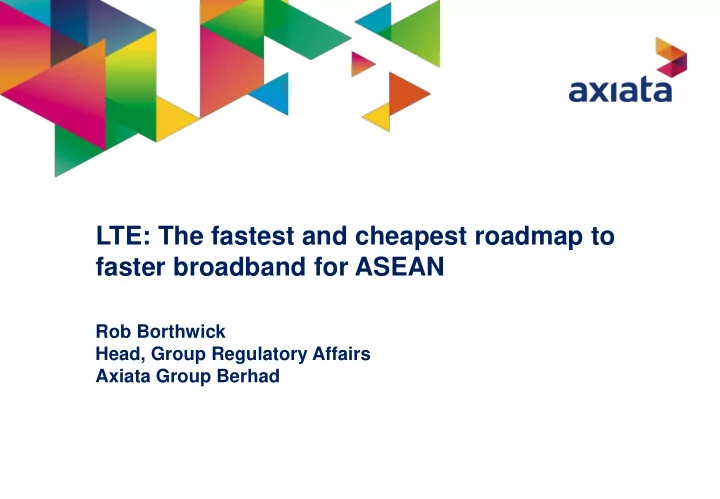

LTE: The fastest and cheapest roadmap to faster broadband for ASEAN Rob Borthwick Head, Group Regulatory Affairs Axiata Group Berhad
About Axiata A leader in emerging Asian mobile telecoms markets. Aspires to be an Asian Regional Champion by 2016 2013 9 countries 23,000 employees > 240 million customers USD 5.8 billion revenue in cash 2 company confidential
Starting Point: The unconnected are shrinking with the democratisation of (mobile) computing Source: Benedict Evans, Mobile is eating the World , 28 October 2014 3 company confidential
Growth of smartphone (& other mobile device) base drives aggregate demand for data. Smartphones have high utility for consumers including for internet access and OTT services Smartphone prices are falling and are now from USD25-40 for Android 3G and sub-USD100 for white label LTE in China/Europe. 2 bands now have ~1,000 handsets. 7 bands ~500 handsets. Internationally 35 per cent penetration seems to be a trigger for faster smartphone uptake. OpCo smartphone penetration US smartphone penetration 4Q, 2011 4Q, 2013 4Q, 2013 3Q,2014 Celcom 17% 23% 32% 41% XL 12% 14% 17% 25% Dialog 9% 13% 16% 22% Robi 6% 6% 7% 11% Source: Axiata, 3Q FPA, 2014 4 company confidential
Strategic operator response #1: invest to improve data experience for customers with 3G and LTE The above speeds are with carrier aggregation. Access to these enhanced speeds also depends on the category of LTE capable phone. Current standard is Category 4. Category 6 devices are starting to be released, and will make use of up to 60 MHz of spectrum. 5 company confidential
Strategic operator response #2: Faced with rapidly growing data demand, move to achieve lower unit cost New technology slashes unit costs…. “A single site can deliver more data (Mbytes) in the same spectrum so lowering the cost per unit. This figure doesn’t include the benefit of operating in 2x20 MHz in the 1800 MHz band which triples capacity of a 2x10 MHz site .” Analysys Mason “LTE allows operators to provide 6 – 10 times as much data at the same site (costing about the same or less) which leads to a massive reduction of cost per Mbyte .” McKinsey Under competitive conditions expect this to translate into pricing pressure which leads to widespread low cost broadband. 6 company confidential
LTE Developments in ASEAN Planned MPT Beeline LTE licence 1.8 GHz deployment LTC 2.6 GHz 1.8 GHz Smart, Globe 850/1.8/2.1 GHz Trialling DTAC, Truemove 1.8 and 2.1 GHz Maxis, Celcom, Digi, Umobile P1, YTL, TM etc 800/1.8/2.3/2.6 GHz Smart Axiata 1.8 GHz (Jan2014) DST deployed 1.8 GHz (Nov2013) Singtel, Starhub, M1 1.8/2.6 GHz • 900 MHz (specific areas only) • Regional 2.3 GHz • 1800 MHz planned 7 company confidential
Total spectrum assigned to mobile operators in ASEAN lags assignments in North America and the EU In spectrum terms ASEAN is not a homogeneous region. We have significant variation with between 400 MHz and over 600 MHz in total national spectrum actually allocated to operators. Global Discussions on Identifying Additional Spectrum for IMT Despite more regionally harmonized spectrum, this potential competitive advantage is dissipated as spectrum allocated does not reflect higher regional harmonized spectrum availability Source: GSMA; Plum Consulting 8 company confidential
ASEAN can maximize its use of IMT spectrum through more coordinated examination of current and new IMT spectrum Operators in competitor regions (EU and US) have access to more harmonized spectrum and are re-farming rapidly to complement more extensive fixed infrastructure. This is providing these regions with higher aggregate national data capacity at lower cost. SPECTRUM AVAILABILITY AVAILABILITY 2013 SPECTRUM FORECAST The practical difference between a national industry total of 1200 MHz spectrum by 2020 (EU) and 700 MHz (ASEAN) is: 50% cheaper unit production of broadband services in core urban economic areas. The furthest rural broadband coverage can also see substantial savings depending on the lowest harmonized band made available for use: 900 MHz vs 700 MHz, 700 MHz vs 450 MHz – again expect savings of up to 50% for new rural networks serving remote, rural areas. 9 company confidential
Route forward for More Efficient National Spectrum Use 1. Identify current spectrum in use for IMT and compare this to total Region 3 spectrum. What are the reasons for variation and possibilities for national re-farming to IMT? This should include planning for refarming of the key APT 700 MHz band. 2. Identification of spectrum held by operators and opportunities for re-farming to 3G and LTE. How can capacity be maximized by re-farming to address 850 / 900 band interference and re- assignment to create larger spectrum blocks? 3. Enable re-farming by a transition to technology-neutral spectrum allocations and service- neutral licence terms and conditions. After initial transition re-farming should be operator-led. 4. A shared goal of regulators and operators should be spectrum reform to accelerate the process of 3G / LTE take-up so consumers have access to faster, affordable broadband. The faster this process occurs the higher the national economic benefit. 5. Expect LTE will dominate in medium term. Sustainable competition requires operators to have a mixed portfolio of lower and higher band spectrum, ideally in large, contiguous allocations. 6. While competitive neutrality also matters, this is primarily an issue for suppliers. It is less important for governments and consumers and uneven spectrum allocations will persist even in concentrated markets. ASEAN regulators have a holistic opportunity to address major spectrum imbalances during release of APT 700 MHz spectrum and, where industry is fragmented, by encouraging consolidation. Sources: GSMA / Axiata / WPC 10 company confidential
Recommend
More recommend